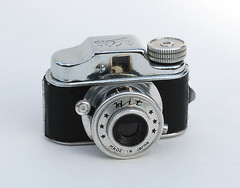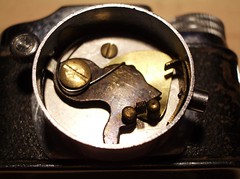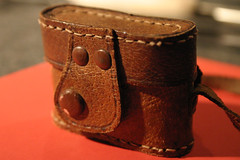Hit

|

|
| the one ... | shutter |

|

|
| case | ... and the other wide-spread version |
After WWII the Japanese had a period of low spending capacity. So they enjoyed using cameras which didn't use much film material, cameras for making 14×14mm exposures on narrow paper-backed 17.5mm film. This kept film costs affordable. The main design used for all those cameras was that of a miniature version of a simple contemporary 35mm viewfinder camera, with leatherette covered body, chrome plated parts, self-cocking shutter and characteristic top with simple viewfinder and film advance knob. Most of these cameras had a non-focusable lens with fixed small aperture, a shutter with bulb and instant mode, and a film advance control window in the back. The Tōgōdō Seisakusho branch of Tougodo made simple versions of that camera type, and the name of its subminis became the synonym for that camera type: HIT . Several other Japanese 17.5mm still cameras had a quite similar design, some were more sophisticated, and all are called "Hit"-type cameras today.
The original Hit has a f/11 lens, a self-cocking shutter with release lever at the lens tube, and an advance knob that can't be turned into the wrong direction. Its production started in the years when Japanese cameras were marked "Made in occupied Japan (1947-1951), probably in 1950. The earliest have a 30mm lens and just instant mode. Later models have also B mode and a mode switch lever at the lens tube, opposite to the shutter release.
Links
- Collecting Hit type cameras article in ePhotiZine [1]
- Luke's Hit cameras at Luke Cole's [2]